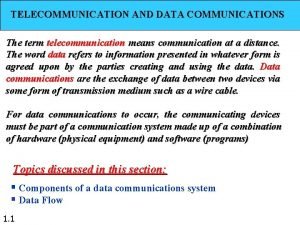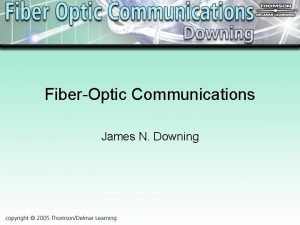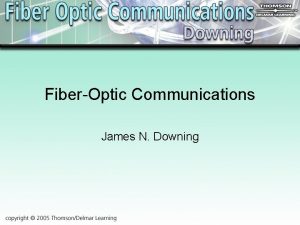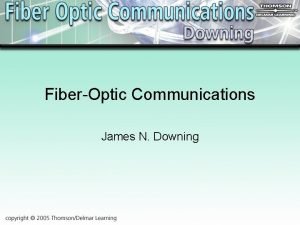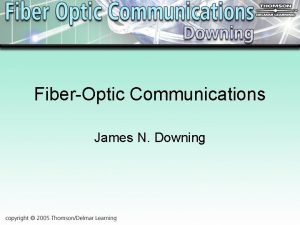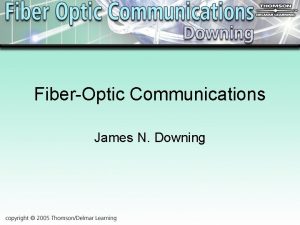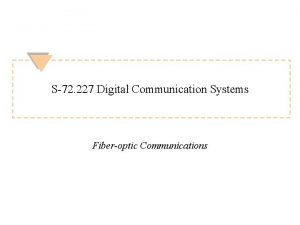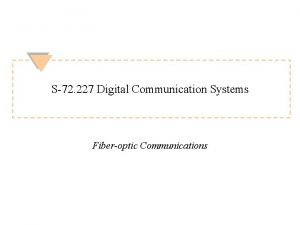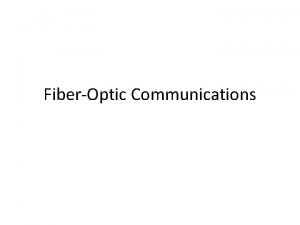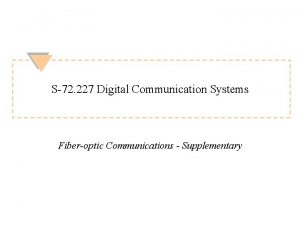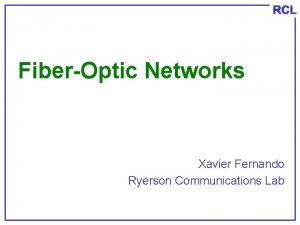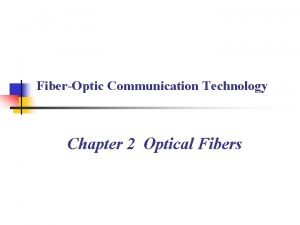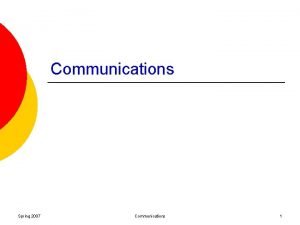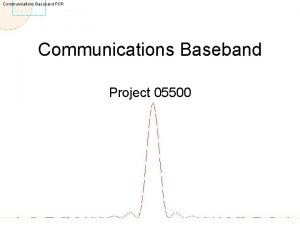FiberOptic Communications James N Downing Chapter 2 Principles

Fiber-Optic Communications James N. Downing

Chapter 2 Principles of Optics

Chapter 2 2. 1 Geometrical Optics – A model by which the nature of light is used to explain refraction, reflection, and propagation of light Refraction: – The bending of light as it passes through a medium – Index of refraction: The ratio of the speed of light in a vacuum to the speed of light in the medium – Phase velocity: The speed of light in a medium – Optical path length: apparent length of an optical element

Chapter 2 2. 1 Geometrical Optics Snell’s Law – Mathematical determination of the index of refraction at the interface of two media – Critical angle is the angle at which the refracted ray is at 900 to the normal

Chapter 2 2. 1 Geometrical Optics Reflection – Bouncing off of rays from a material interface – Depends on the smoothness of the surface and the refractive indices of the media Fresnel reflection law – Determines the fraction of light reflected as a function of the incident ray as well as the amount of light refracted or transmitted into the medium

Chapter 2 2. 2 Wave Optics Electromagnetic Waves – Result of the dual properties of electricity and magnetism and their relationship – Derived from Maxwell’s equations – Electric waves and magnetic equations are perpendicular to each other – Function of both space and time – Electromagnetic spectrum consists of all forms of electromagnetic energy

Chapter 2 2. 2 Wave Optics Polarization – Describes the direction of the electric field oscillations – Induced by preferential reflection, transmission, scattering, or passing light through a birefringent material – May be either perpendicular, horizontal, z-axis, circular, or elliptical

Chapter 2 2. 2 Wave Optics Coherence – Phase difference is the shift between two waves along their axis of propagation – Coherent light—no phase shift – Incoherent light—phase is continually shifting – Temporal coherence —waves are equal – Spatial coherence—waves are in phase at a point in space

Chapter 2 2. 2 Wave Optics Interference – Due to the linear superposition of electromagnetic waves such that the amplitude at any point is equal to the sum of the individual amplitudes at that point Constructive interference – Phase shift is zero Destructive interference – Phase shift is 1800

Chapter 2 2. 2 Wave Optics Diffraction – Diffraction describes how light can spread out after going through a small aperture. – Diffraction grating is the separation of the diffracted light into different bands of different colors.

Chapter 2 2. 2 Wave Optics Scattering – Scattering is the spreading apart of light caused by interaction with matter. – Rayleigh scattering, or molecular scattering, is caused by small particles of matter (less than or equal to 1/10 wavelength) interacting with light. – Mie scattering is due to interaction with matter larger than 1/10 wavelength of light.

Chapter 2 2. 3 Quantum Optics Bohr Model – Consists of nucleus and orbitals – Nucleus contains the protons and neutrons – The orbital contains the electrons

Chapter 2 2. 3 Quantum Optics Absorption – Ground state is the minimum level of energy needed to keep an electron associated with its orbit. – Excited state is that in which the electron has absorbed some energy. – Absorption is the process in which light energy is converted into electrical energy. – Beer’s Law describes the absorption transfer function.

Chapter 2 2. 3 Quantum Optics Emission – Emission is the process by which electrical energy is converted to light. – Spontaneous emission occurs naturally. – Stimulated emission occurs when an external photon causes a photon to lose energy. – Linewidth is the length of a wavelength of light (defined at the 50% power level).

Chapter 2 2. 3 Quantum Optics Planck’s Law – This law describes the energy released when an electron moves from one energy level to another.

Chapter 2 2. 4 Nonlinear Optics Four-Wave Mixing – Four-wave mixing results in a fourth frequency when three frequency signals are combined. – Can be used to generate a fourth frequency, if needed. – Problems arise when the fourth frequency is already in use.

Chapter 2 2. 4 Nonlinear Optics Phase Modulation – The result of a change in the refractive index with a change in light intensity – Self-phase results in a broadening of the linewidth of a particular signal – Cross-phase occurs when self-phase modulation causes phase changes in another signal. which results in a linewidth broadening at another wavelength.

Chapter 2 2. 4 Nonlinear Optics Brillouin Scattering – Occurs at optical powers high enough to generate small acoustic waves in the material – Alters the refractive index, and shifts the frequency – Scattering increases as power increases

Chapter 2 2. 4 Nonlinear Optics Raman Scattering – Light is absorbed and some energy is lost or gained from molecular vibrations. – Can be used to transfer energy from one wavelength to another resulting in signal amplification. – Cross-talk may be enhanced if more than one wavelength is used.

Chapter 2 2. 5 Optical Power Radiometric and Photometric Quantities – Photometric quantities describe the visual brightness of a light and exist only between 400 nm and 700 nm with a peak at 550 nm. – Radiometric quantities are consistent throughout the spectrum and are proportional to the square of the energy.

Chapter 2 2. 5 Optical Power – The ratio of energy per unit time (measured in watts or d. Bm) – Transfer function: Td. B = Pout-d. Bm – Pin-d. Bm
- Slides: 21



















